
The Taj Mahal, is an ivory-white marble mausoleum on the right bank of the river Yamuna in the Indian city of Agra. It was commissioned in 1632 by the Mughal emperor Shah Jahan to house the tomb of his favourite wife, Mumtaz Mahal; it also houses the tomb of Shah Jahan himself. The tomb is the centrepiece of a 17-hectare (42-acre) complex, which includes a mosque and a guest house, and is set in formal gardens bounded on three sides by a crenellated wall.

The Peacock Throne was a famous jewelled throne that was the seat of the emperors of the Mughal Empire in India. It was commissioned in the early 17th century by Emperor Shah Jahan and was located in the Diwan-i-Khas in the Red Fort of Delhi. It was named after a peacock as two peacocks are shown dancing at its rear.
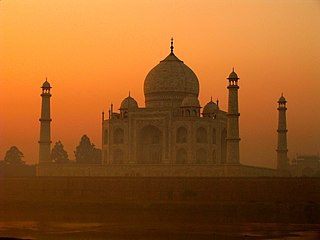
Agra is a city on the banks of the Yamuna river in the Indian state of Uttar Pradesh, about 210 kilometres (130 mi) south of the national capital New Delhi and 335 km west of the state capital Lucknow. Known as the Dalit capital of UP, with a population of roughly 1.6 million, Agra is the fourth-most populous city in Uttar Pradesh and twenty-third most populous city in India.

Mumtaz Mahal was the empress consort of the Mughal Empire from 19 January 1628 to 17 June 1631 as the chief consort of the Mughal emperor Shah Jahan. The Taj Mahal in Agra, often cited as one of the Wonders of the World, was commissioned by her husband to act as her tomb.

The Lahore Fort is a citadel in the city of Lahore, Punjab, Pakistan. The fortress is located at the northern end of walled city Lahore, and spreads over an area greater than 20 hectares. It contains 21 notable monuments, some of which date to the era of Emperor Akbar. The Lahore Fort is notable for having been almost entirely rebuilt in the 17th century, when the Mughal Empire was at the height of its splendour and opulence.
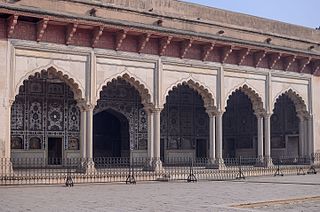
The Sheesh Mahal is located within the Shah Burj block in northern-western corner of Lahore Fort. It was constructed under the reign of Mughal Emperor Shah Jahan in 1631–32, with some additions later under Sikh Maharaja Ranjit Singh. The ornate white marble pavilion is inlaid with pietra dura and complex mirror-work of the finest quality. The hall was reserved for personal use by the imperial family and close aides. It is among the 21 monuments that were built by successive Mughal emperors inside Lahore Fort, and forms the "jewel in the Fort’s crown." As part of the larger Lahore Fort Complex, it has been inscribed as a UNESCO World Heritage Site since 1981.

Agra Fort is a historical fort in the city of Agra in India. It was the main residence of the emperors of the Mughal Dynasty until 1638, when the capital was shifted from Agra to Delhi. Before capture by the British, the last Indian rulers to have occupied it were the Marathas. In 1983, the Agra fort was life inscribed as a UNESCO World Heritage Site. It is about 2.5 km northwest of its more famous sister monument, the Taj Mahal. The fort can be more accurately described as the walled city.

Mughal architecture is the type of Indo-Islamic architecture developed by the Mughals in the 16th, 17th and 18th centuries throughout the ever-changing extent of their empire in the Indian subcontinent. It developed the styles of earlier Muslim dynasties in India as an amalgam of Islamic, Persian and Indian architecture. Mughal buildings have a uniform pattern of structure and character, including large bulbous domes, slender minarets at the corners, massive halls, large vaulted gateways, and delicate ornamentation; Examples of the style can be found in modern-day Afghanistan, Bangladesh, India and Pakistan.

The Red Fort or Lal Qila is a historic fort in Old Delhi, Delhi in India that served as the main residence of the Mughal Emperors. Emperor Shah Jahan commissioned construction of the Red Fort on 12 May 1638, when he decided to shift his capital from Agra to Delhi. Originally red and white, its design is credited to architect Ustad Ahmad Lahori, who also constructed the Taj Mahal. The fort represents the peak in Mughal architecture under Shah Jahan, and combines Persianate palace architecture with Indian traditions.

Tomb of I'timād-ud-Daulah is a Mughal mausoleum in the city of Agra in the Indian state of Uttar Pradesh. Often described as a "jewel box", sometimes called the "Bachcha Taj" or the "Baby Taj", the tomb of I'timād-ud-Daulah is often regarded as a draft of the Taj Mahal.
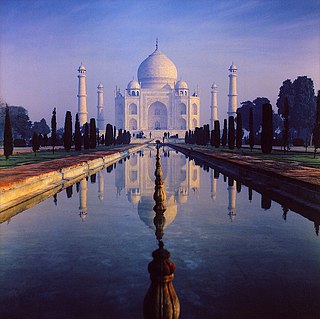
The Taj Mahal represents the finest and most sophisticated example of Indo-Islamic architecture. Its origins lie in the moving circumstances of its commission and the culture and history of an Islamic Mughal empire's rule of large parts of India. The distraught Mughal Emperor Shah Jahan commissioned the project upon the death of one of his favorite wives Mumtaz Mahal.

Moti Masjid, one of the "Pearl Mosques", is a 17th-century religious building located inside the Lahore Fort, Lahore, Punjab, Pakistan. It is a small, white marble structure built by Mughal emperor Jahangir and modified by the architects of Shah Jahan, and is among his prominent extensions to the Lahore Fort Complex. The mosque is located on the western side of Lahore Fort, closer to Alamgiri Gate, the main entrance.

The Jama Mosque is a 17th-century congregational mosque located in the historic core of Agra, Uttar Pradesh. It was built by Jahanara Begum, Padshah Begum of the Mughal Empire, during the reign of her father, Mughal Emperor Shah Jahan. It is one of the largest mosques in India. Today it is still in use, serving as the principal mosque for the city of Agra. It stands opposite to the Agra Fort, and overlooks the Agra Fort Railway Station.
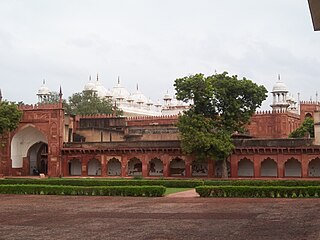
The Moti Masjid is a 17th-century congregational mosque located within the Agra Fort UNESCO World Heritage Site. Built by Mughal Emperor Shah Jahan, the mosque is made entirely of white marble.
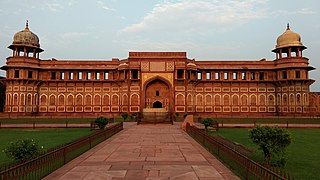
Jahangiri Mahal may be the most noteworthy building inside the Agra Fort of India. The Mahal was the principal zenana, and was used mainly by the Rajput wives of Akbar. It is a form of Islamic architecture.

Musamman Burj also known as the Saman Burj or the Shah-burj, is an octagonal tower standing close to the Shah Jahan's private hall Diwan-e-Khas in Agra Fort.

The Naulakha Pavilion is a white marble personal chamber with a curvilinear roof, located beside the Sheesh Mahal courtyard, in the northern section of the Lahore Fort in Lahore, Pakistan. The monument is one of the 21 monuments situated within the Lahore Fort, with its western façade providing a panoramic view of the ancient city of Lahore.

The architecture of Uttar Pradesh demonstrates a diverse and eclectic combination of Buddhist, Hindu, Indo-Islamic and Indo-European architectural styles. Two of its architectural monuments—the Taj Mahal, the Agra Fort as well as the township of Fatehpur Sikri founded by the famous Mughal Emperor Akbar are designated UNESCO World Heritage Sites. The architectural structures in Uttar Pradesh include Buddhist Stupas and Viharas, ancient monasteries, townships, forts, palaces, temples, mosques, mausoleums, memorials and other community structures. Uttar Pradesh's architectural structures also includes Hindu temples, Ghats etc. largely found in ancient cities like Varanasi, Brindaban (Vrindavan), Mathura, Prayagraj.

The Diwan-i-Khas, or Hall of Private Audiences, was a chamber in the Red Fort of Delhi built-in 1648 as a location for receptions. It was the location where the Mughal Emperor Shah Jahan received courtiers and state guests. It was also known as the Shah Mahal.

Persian Inscriptions on Indian Monuments is a book written in Persian by Dr Ali Asghar Hekmat E Shirazi and published in 1956 and 1958 and 2013. New edition contains the Persian texts of more than 200 epigraphical inscriptions found on historical monuments in India, many of which are currently listed as national heritage sites or registered as UNESCO world heritage, published in Persian; an English edition is also being printed.





















